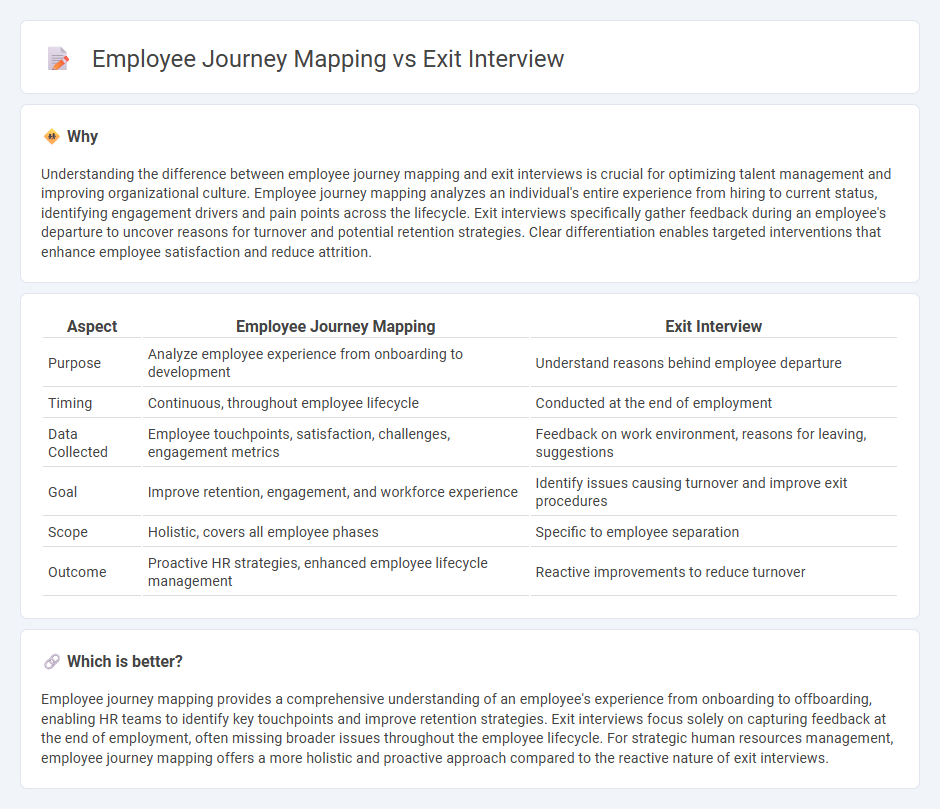
Employee journey mapping captures the comprehensive experience of employees from recruitment through development, engagement, and retention phases, offering proactive insights for improving workplace culture and productivity. Exit interviews focus specifically on gathering feedback at the end of employment to identify issues leading to turnover and enhance future retention strategies. Explore how both tools can synergistically optimize talent management in your organization.
Why it is important
Understanding the difference between employee journey mapping and exit interviews is crucial for optimizing talent management and improving organizational culture. Employee journey mapping analyzes an individual's entire experience from hiring to current status, identifying engagement drivers and pain points across the lifecycle. Exit interviews specifically gather feedback during an employee's departure to uncover reasons for turnover and potential retention strategies. Clear differentiation enables targeted interventions that enhance employee satisfaction and reduce attrition.
Comparison Table
| Aspect | Employee Journey Mapping | Exit Interview |
|---|---|---|
| Purpose | Analyze employee experience from onboarding to development | Understand reasons behind employee departure |
| Timing | Continuous, throughout employee lifecycle | Conducted at the end of employment |
| Data Collected | Employee touchpoints, satisfaction, challenges, engagement metrics | Feedback on work environment, reasons for leaving, suggestions |
| Goal | Improve retention, engagement, and workforce experience | Identify issues causing turnover and improve exit procedures |
| Scope | Holistic, covers all employee phases | Specific to employee separation |
| Outcome | Proactive HR strategies, enhanced employee lifecycle management | Reactive improvements to reduce turnover |
Which is better?
Employee journey mapping provides a comprehensive understanding of an employee's experience from onboarding to offboarding, enabling HR teams to identify key touchpoints and improve retention strategies. Exit interviews focus solely on capturing feedback at the end of employment, often missing broader issues throughout the employee lifecycle. For strategic human resources management, employee journey mapping offers a more holistic and proactive approach compared to the reactive nature of exit interviews.
Connection
Employee journey mapping identifies key touchpoints throughout the employment lifecycle, providing insights to enhance engagement and retention strategies. Exit interviews collect critical feedback at the end of employment, revealing reasons for turnover and areas for improvement. Combining these tools enables Human Resources to optimize workforce management by aligning employee experiences with organizational goals and reducing attrition rates.
Key Terms
**Exit Interview:**
Exit interviews provide crucial insights by capturing employees' reasons for leaving, highlighting organizational weaknesses, and identifying improvement opportunities in retention strategies. This qualitative feedback complements quantitative employee journey mapping by focusing specifically on the end-of-employment experience rather than the entire employee lifecycle. Discover how leveraging exit interviews can enhance your workforce engagement and reduce turnover rates.
Offboarding
Exit interviews provide crucial feedback on employee experience, highlighting reasons for departure and areas for organizational improvement during offboarding. Employee journey mapping offers a comprehensive visualization of the offboarding process, identifying pain points and opportunities to enhance the transition. Explore these strategies in depth to optimize your offboarding practices.
Feedback
Exit interviews provide critical feedback directly from departing employees, highlighting specific reasons behind turnover and identifying areas needing improvement. Employee journey mapping captures ongoing feedback throughout an employee's tenure, offering a comprehensive view of experiences and pain points at each stage of their employment lifecycle. Explore how combining these feedback methods can enhance retention strategies and workplace culture.
Source and External Links
Exit interview - Wikipedia - An exit interview is a survey conducted with someone leaving an organization, focusing on reasons for departure, job satisfaction, and feedback on company policies, culture, and management to help improve workplace practices.
Exit interview: What is it and the questions to expect - Personio - An exit interview is a final, confidential conversation with a departing employee, ideally held by HR in a neutral setting, to gather honest feedback on what the organization can improve to retain future talent.
38 Exit Interview Questions to Ask Employees [Free Template] - AIHR - Exit interviews are structured meetings or surveys that allow employers to learn from a departing employee's experiences, covering topics like job satisfaction, company culture, work environment, and reasons for leaving, often conducted by a neutral HR representative.
 dowidth.com
dowidth.com